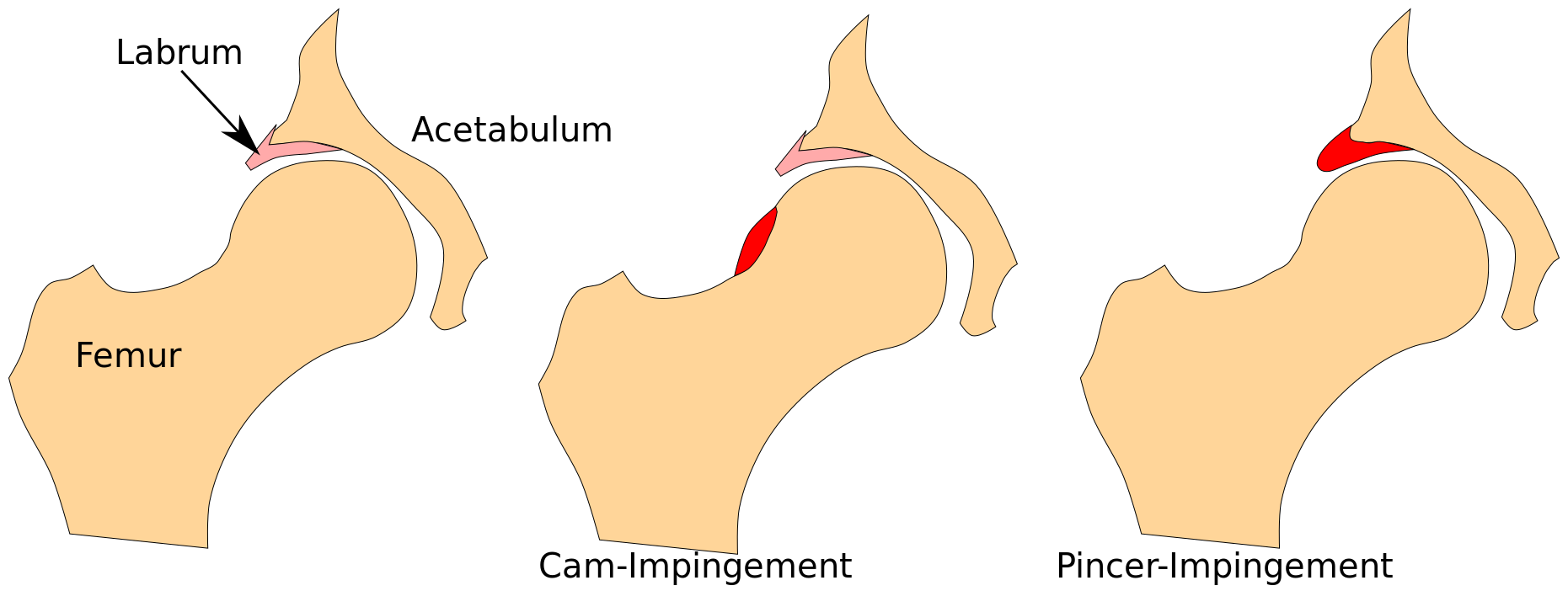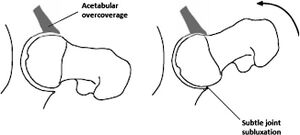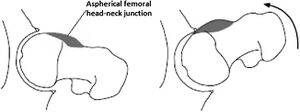Femoroacetabular Impingement: Difference between revisions
No edit summary |
No edit summary |
||
| Line 2: | Line 2: | ||
{{Condition | {{Condition | ||
|quality=Stub | |quality=Stub | ||
|image=Femoral acetabular impingement FAI.svg | |||
|caption=Normal, CAM, and pincer morphologies. | |||
}} | }} | ||
'''Femoroacetabular impingement''' (FAI) refers to abnormally shaped femoral head and neck junction and/or acetabulum. This creates a space conflict with hip flexion. It is a risk factor for early onset [[Hip Osteoarthritis|hip osteoarthritis]], but is not a sufficient cause. | '''Femoroacetabular impingement''' (FAI) refers to abnormally shaped femoral head and neck junction and/or acetabulum. This creates a space conflict with hip flexion. It is a risk factor for early onset [[Hip Osteoarthritis|hip osteoarthritis]], but is not a sufficient cause. | ||
| Line 13: | Line 15: | ||
Pain is felt in the groin or in an area. The patient often uses a C grip with their index finger and thumb proximal to the greater trochanter to indicate the painful region. There may be limited flexion or internal rotation of the hip and provocation of groin pain with FADDIR test. | Pain is felt in the groin or in an area. The patient often uses a C grip with their index finger and thumb proximal to the greater trochanter to indicate the painful region. There may be limited flexion or internal rotation of the hip and provocation of groin pain with FADDIR test. | ||
== Prognosis == | ==Prognosis== | ||
The CHECK study assessed 1002 patients aged 45–65 years with early symptoms of hip OA but without definite radiographic evidence of the same over 5 years. At baseline, 76% of the included hips had no radiographic signs of osteoarthritis and 24% doubtful osteoarthritis. Cam deformities and acetabular dysplasia were shown to be associated with an increased [[Odds Ratio|odds ratio]] for progression to early onset osteoarthritis.<ref>{{Cite journal|last=Agricola|first=Rintje|last2=Heijboer|first2=Marinus P.|last3=Bierma-Zeinstra|first3=Sita M. A.|last4=Verhaar|first4=Jan A. N.|last5=Weinans|first5=Harrie|last6=Waarsing|first6=Jan H.|date=2013-06|title=Cam impingement causes osteoarthritis of the hip: a nationwide prospective cohort study (CHECK)|url=https://pubmed.ncbi.nlm.nih.gov/22730371|journal=Annals of the Rheumatic Diseases|volume=72|issue=6|pages=918–923|doi=10.1136/annrheumdis-2012-201643|issn=1468-2060|pmid=22730371}}</ref> While pincer changes were actually associated with a ''reduced'' risk.<ref>{{Cite journal|last=Agricola|first=R.|last2=Heijboer|first2=M. P.|last3=Roze|first3=R. H.|last4=Reijman|first4=M.|last5=Bierma-Zeinstra|first5=S. M. A.|last6=Verhaar|first6=J. a. N.|last7=Weinans|first7=H.|last8=Waarsing|first8=J. H.|date=2013-10|title=Pincer deformity does not lead to osteoarthritis of the hip whereas acetabular dysplasia does: acetabular coverage and development of osteoarthritis in a nationwide prospective cohort study (CHECK)|url=https://pubmed.ncbi.nlm.nih.gov/23850552|journal=Osteoarthritis and Cartilage|volume=21|issue=10|pages=1514–1521|doi=10.1016/j.joca.2013.07.004|issn=1522-9653|pmid=23850552}}</ref> | The CHECK study assessed 1002 patients aged 45–65 years with early symptoms of hip OA but without definite radiographic evidence of the same over 5 years. At baseline, 76% of the included hips had no radiographic signs of osteoarthritis and 24% doubtful osteoarthritis. Cam deformities and acetabular dysplasia were shown to be associated with an increased [[Odds Ratio|odds ratio]] for progression to early onset osteoarthritis.<ref>{{Cite journal|last=Agricola|first=Rintje|last2=Heijboer|first2=Marinus P.|last3=Bierma-Zeinstra|first3=Sita M. A.|last4=Verhaar|first4=Jan A. N.|last5=Weinans|first5=Harrie|last6=Waarsing|first6=Jan H.|date=2013-06|title=Cam impingement causes osteoarthritis of the hip: a nationwide prospective cohort study (CHECK)|url=https://pubmed.ncbi.nlm.nih.gov/22730371|journal=Annals of the Rheumatic Diseases|volume=72|issue=6|pages=918–923|doi=10.1136/annrheumdis-2012-201643|issn=1468-2060|pmid=22730371}}</ref> While pincer changes were actually associated with a ''reduced'' risk.<ref>{{Cite journal|last=Agricola|first=R.|last2=Heijboer|first2=M. P.|last3=Roze|first3=R. H.|last4=Reijman|first4=M.|last5=Bierma-Zeinstra|first5=S. M. A.|last6=Verhaar|first6=J. a. N.|last7=Weinans|first7=H.|last8=Waarsing|first8=J. H.|date=2013-10|title=Pincer deformity does not lead to osteoarthritis of the hip whereas acetabular dysplasia does: acetabular coverage and development of osteoarthritis in a nationwide prospective cohort study (CHECK)|url=https://pubmed.ncbi.nlm.nih.gov/23850552|journal=Osteoarthritis and Cartilage|volume=21|issue=10|pages=1514–1521|doi=10.1016/j.joca.2013.07.004|issn=1522-9653|pmid=23850552}}</ref> | ||
[[Category:Pelvis, Hip and Thigh Conditions]] | |||
<references /> | |||
{{References}} | {{References}} | ||
{{Reliable sources}} | {{Reliable sources}} | ||
Revision as of 20:06, 15 April 2022

| |
| Femoroacetabular Impingement |
|---|
Femoroacetabular impingement (FAI) refers to abnormally shaped femoral head and neck junction and/or acetabulum. This creates a space conflict with hip flexion. It is a risk factor for early onset hip osteoarthritis, but is not a sufficient cause.
Classification


There are two patterns, cam and pincer, as well as a combination of both types. In cam FAI there is a thickened, aspherical femoral head-neck junction, which abuts against the anterosuperior labrum with hip flexion, and results in compression of the labrum and acetabular cartilage. This leads to separation of the labrum from the acetabular cartilage and delamination of the acetabular cartilage from the subchondral bone.[1]
In pincer FAI, there is an overcoverage of the acetabulum with a deepened acetabular on the femoral head. The femoral neck abuts against the acetabular labrum and compresses it, damaging both the labrum and underlying cartilage. Lesions usually occur anterosuperiorly from hip flexion like with cam lesions, but also posteroinferiorly from posterior subluxation due to continued flexion causing a contre-coup lesion.
Clinical Features
Pain is felt in the groin or in an area. The patient often uses a C grip with their index finger and thumb proximal to the greater trochanter to indicate the painful region. There may be limited flexion or internal rotation of the hip and provocation of groin pain with FADDIR test.
Prognosis
The CHECK study assessed 1002 patients aged 45–65 years with early symptoms of hip OA but without definite radiographic evidence of the same over 5 years. At baseline, 76% of the included hips had no radiographic signs of osteoarthritis and 24% doubtful osteoarthritis. Cam deformities and acetabular dysplasia were shown to be associated with an increased odds ratio for progression to early onset osteoarthritis.[2] While pincer changes were actually associated with a reduced risk.[3]
- ↑ 1.0 1.1 1.2 Murphy, Nicholas J.; Eyles, Jillian P.; Hunter, David J. (2016-11). "Hip Osteoarthritis: Etiopathogenesis and Implications for Management". Advances in Therapy. 33 (11): 1921–1946. doi:10.1007/s12325-016-0409-3. ISSN 1865-8652. PMC 5083776. PMID 27671326. Check date values in:
|date=(help) - ↑ Agricola, Rintje; Heijboer, Marinus P.; Bierma-Zeinstra, Sita M. A.; Verhaar, Jan A. N.; Weinans, Harrie; Waarsing, Jan H. (2013-06). "Cam impingement causes osteoarthritis of the hip: a nationwide prospective cohort study (CHECK)". Annals of the Rheumatic Diseases. 72 (6): 918–923. doi:10.1136/annrheumdis-2012-201643. ISSN 1468-2060. PMID 22730371. Check date values in:
|date=(help) - ↑ Agricola, R.; Heijboer, M. P.; Roze, R. H.; Reijman, M.; Bierma-Zeinstra, S. M. A.; Verhaar, J. a. N.; Weinans, H.; Waarsing, J. H. (2013-10). "Pincer deformity does not lead to osteoarthritis of the hip whereas acetabular dysplasia does: acetabular coverage and development of osteoarthritis in a nationwide prospective cohort study (CHECK)". Osteoarthritis and Cartilage. 21 (10): 1514–1521. doi:10.1016/j.joca.2013.07.004. ISSN 1522-9653. PMID 23850552. Check date values in:
|date=(help)
Literature Review
- Reviews from the last 7 years: review articles, free review articles, systematic reviews, meta-analyses, NCBI Bookshelf
- Articles from all years: PubMed search, Google Scholar search.
- TRIP Database: clinical publications about evidence-based medicine.
- Other Wikis: Radiopaedia, Wikipedia Search, Wikipedia I Feel Lucky, Orthobullets,


